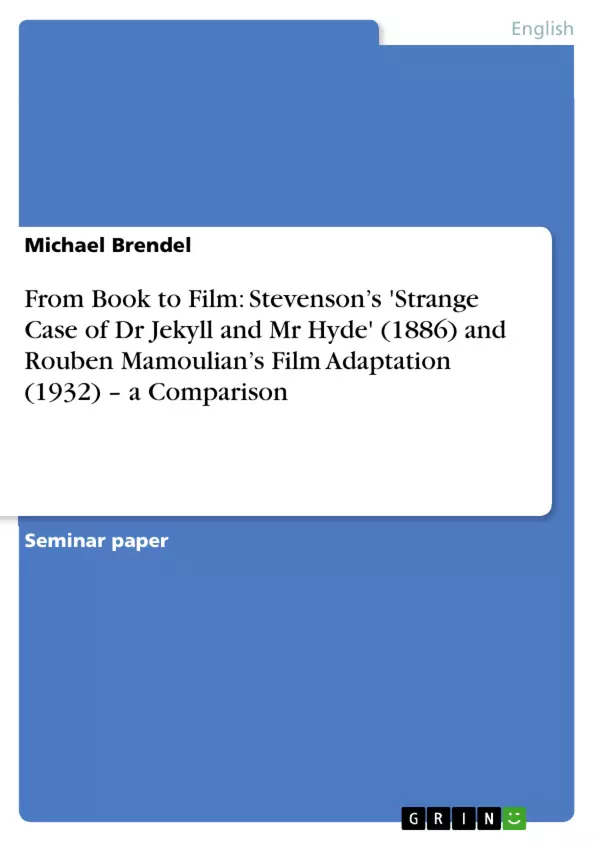On the following pages we will have a closer look at the process of film adaptation by analyzing Rouben Mamoulian’s Dr. Jekyll and Mr. Hyde (1932) – probably the most accomplished film version of Stevenson’s novella – and by comparing it with its literary model. At first, we will recapitulate the complexity of the source text, especially with regard to the question of genre. We will also examine T.R. Sullivan’s theatrical adaptation, which can in some respects be seen as a blueprint for Mamoulian’s film. Then, we will have a look at the literary macrostructure of the film at hand, discuss Mamoulian’s interpretation of Stevenson’s Strange Case and compare the source text with its screen adaptation from a narratological point of view. To finish our analysis, we will shed light on some techniques used by the director in order to communicate his ideas.
Table of Contents
- Introduction
- Main Part
- From Stevenson's Novella to Sullivan's Stage Adaptation
- Jekyll and Hyde as a Complex Mixture of Genres
- T.R. Sullivan's Adaptation of the Source Text
- Mamoulian's Film Adaptation of The Strange Case
- Changes in Literary Macrostructure: Plot and Character Constellation
- Mamoulian's Sexual Reading of Jekyll and Hyde
- Mamoulian's Darwinian Reading of Jekyll and Hyde
- Mamoulian's Adaptation from a Freudian Perspective
- Comparative Narratology
- Narrative Structure
- Narrative Perspective: Focalization and Ocularization
- Cinematic Devices
- Subjective Point-of-View-Shots
- Dissolves
- Split-screens
- Symbols
- From Stevenson's Novella to Sullivan's Stage Adaptation
- Synopsis
- Appendix
- Bibliography
Objectives and Key Themes
This paper examines the adaptation process of Robert Louis Stevenson's Strange Case of Dr. Jekyll and Mr. Hyde, focusing on Rouben Mamoulian's 1932 film adaptation. The analysis aims to explore the complex nature of the source text, its various interpretations, and how Mamoulian's film translates these elements into a cinematic medium.
- The multi-genre nature of Stevenson's novella.
- The various interpretations of Jekyll and Hyde's duality.
- Mamoulian's artistic choices in adapting the story for the screen.
- The comparison of the source text with its screen adaptation from a narratological perspective.
- The cinematic techniques used by Mamoulian to communicate his vision.
Chapter Summaries
The introduction delves into the concept of “tracer texts,” highlighting how Stevenson's novella has become a cultural touchstone, inspiring numerous adaptations across various genres. It also acknowledges the simplification of the source text in many adaptations, emphasizing the significance of interpretations that offer independent and insightful perspectives on the original material.
The first chapter explores the complex nature of Stevenson's novella, examining its elements of detective fiction, gothic fiction, and allegory. It delves into the various interpretations of Jekyll and Hyde's split personality, including religious, moral, and psychosexual readings. The chapter also highlights the impact of Victorian social structures and hypocrisy on the story's themes.
The second chapter focuses on T.R. Sullivan's stage adaptation of the novella, presenting it as a precursor to Mamoulian's film adaptation. It examines the adaptation process and the challenges of translating a literary work onto the stage.
The third chapter delves into Mamoulian's film adaptation, analyzing the changes in plot and character constellation. It explores Mamoulian's unique interpretations of the story, specifically his sexual, Darwinian, and Freudian readings of Jekyll and Hyde's duality.
The fourth chapter provides a comparative narratological analysis of the novella and the film adaptation, examining aspects like narrative structure and perspective.
The fifth chapter focuses on the cinematic techniques employed by Mamoulian, discussing the use of subjective point-of-view shots, dissolves, split-screens, and symbolism. It explores how these techniques contribute to the film's overall message and impact.
Keywords
The main keywords and focuses of the text include Victorian Gothic, literary adaptation, film adaptation, genre, interpretation, Strange Case of Dr. Jekyll and Mr. Hyde, duality, characterization, narrative, cinematic techniques, symbolism, and psychoanalysis.
- Quote paper
- Michael Brendel (Author), 2010, From Book to Film: Stevenson’s 'Strange Case of Dr Jekyll and Mr Hyde' (1886) and Rouben Mamoulian’s Film Adaptation (1932) – a Comparison, Munich, GRIN Verlag, https://www.grin.com/document/150981



